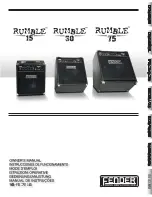
Dangerous Music 2-Bus Manual
4
CHASSIS
and
GROUND
The banana jacks are strapped together during assembly.
They are provided to accommodate grounding systems where the chassis and audio
ground need to be separate.
Front Panel and Use
There are three types of front panel controls on the 2-Bus.
+6dB
gain switches boost the signal patched to any pair of inputs
MONO
switches put the signals of a pair, normally panned hard left and right, up
the middle of a mix.
The
Output Level Trim
is a mix fine gain adjustment used to get the signal level
just right to the mixdown A/D converter, recorder (or EQ/Compressor if in the
chain).
The switches on the front panel are laid out so that the inputs can be treated as stereo
pairs (also known as “stems”) or as individual inputs panned up the middle of a mix. For
sounds that are panned somewhere in between the two extremes, a pair of D/A converters
is used, panning is done with your DAW’s software mixer and the Mono button is not
engaged.
For example, let’s say that one wants to mix a drum kit with bass, guitars, a lead
vocal, and reverb signals together. To keep things simple, let’s say that the engineer has a
DAW with 8 D/A channels available to patch to analog output processing if desired, and
then the 2-Bus. This mix has 8 tracks of drums, one bass, two guitars, one vocal, with
reverb and effects for maybe 2 dozen tracks total. Usually, a DAW user would mix this to
2 tracks and then bounce the result to a new pair of tracks, but by using 4 pairs of outputs,
audio flexibility can be improved by assigning the drums to DAW outputs 1 and 2, the
bass and vocal to 3 and 4, the guitars to 5 and 6, and finally, the effects returns to 7 and 8.
The bass and vocal want their own channels, so they are assigned straight to mono or
direct outputs with no panning, and the
MONO
button on the 2-Bus is pressed to pan
them up the middle. Maybe the drums need gain so the other outputs can be run hot. The
Gain
button for inputs 1 and 2 would take care of this. The 2-Bus Main Output is then
sent to an A/D converter that is recording back into the DAW (or an external device such
as an editing system, tape machine, or CD burner) using the Output Trim Level to set the
gain precisely. Since the tracks are spread among several busses in the computer, the
individual levels can be run much hotter ‘inside the box’ resulting in a mix that has better
clarity, detail, and punch. The use of outboard processing means that individual stems can
be made to slam without using ‘outboard loops’ in the DAW and suffering another A/D
conversion with the inherent time delay issues and another digital fader with its loss of





























